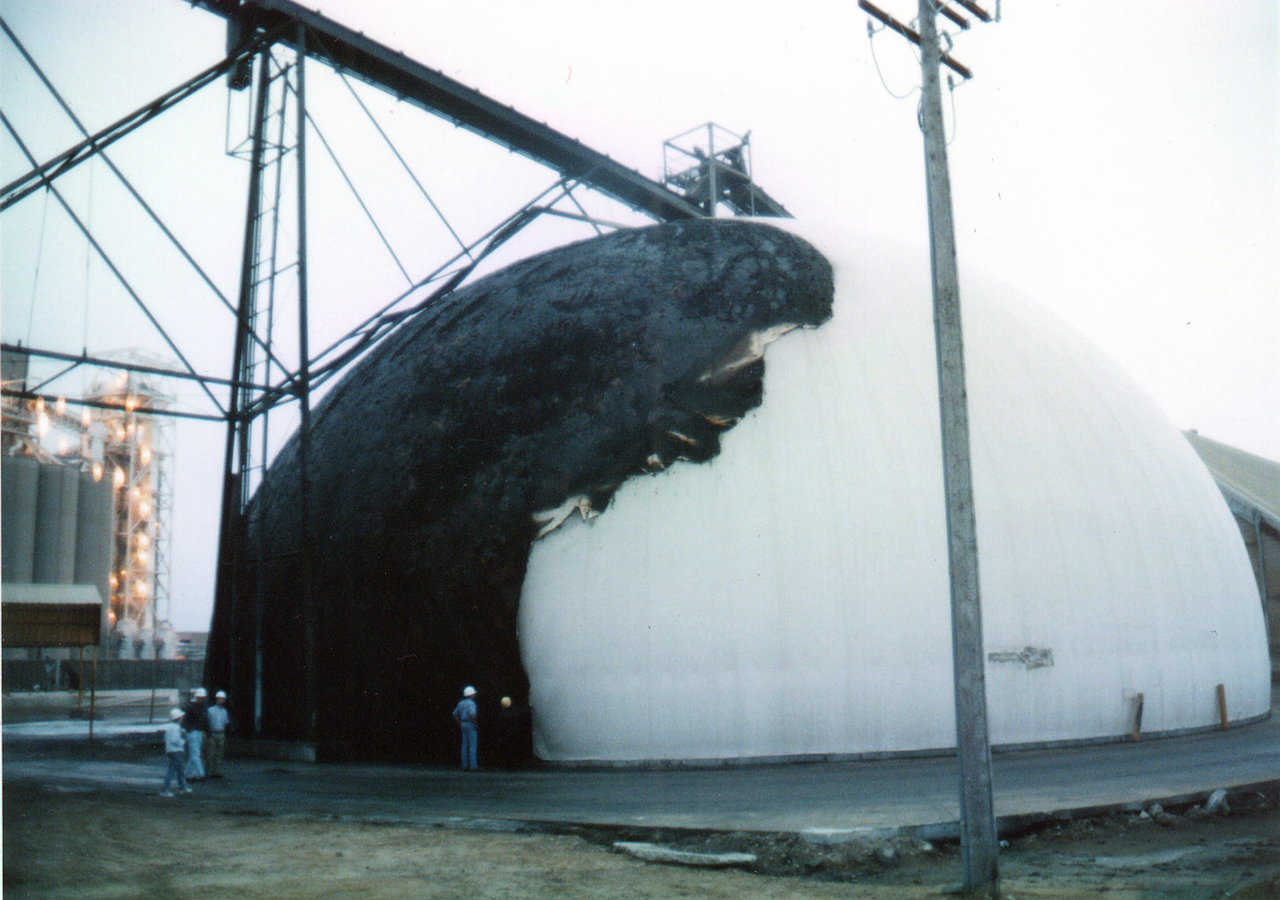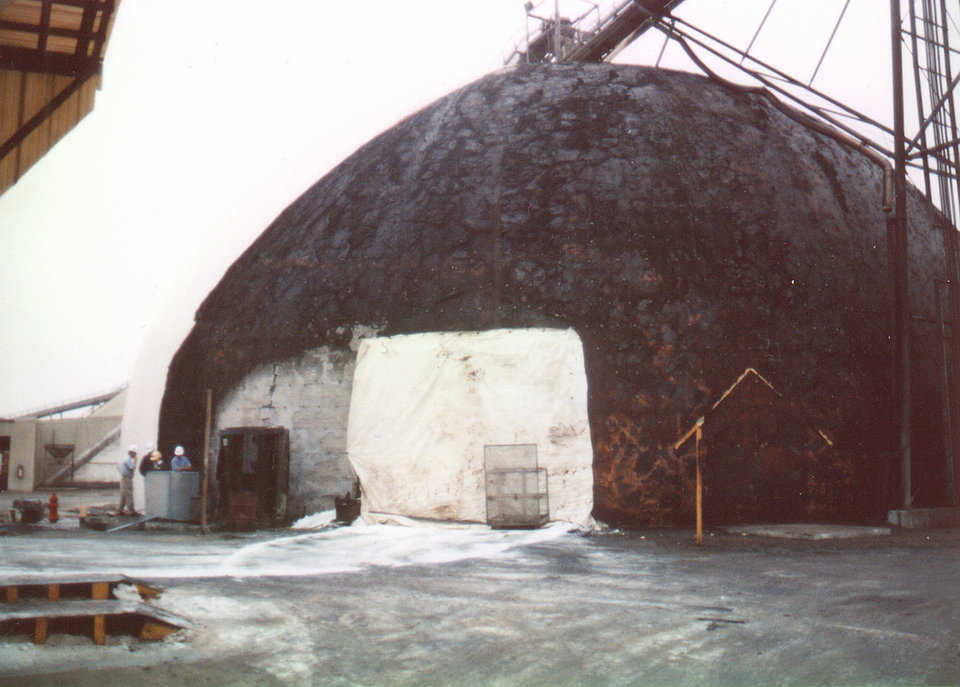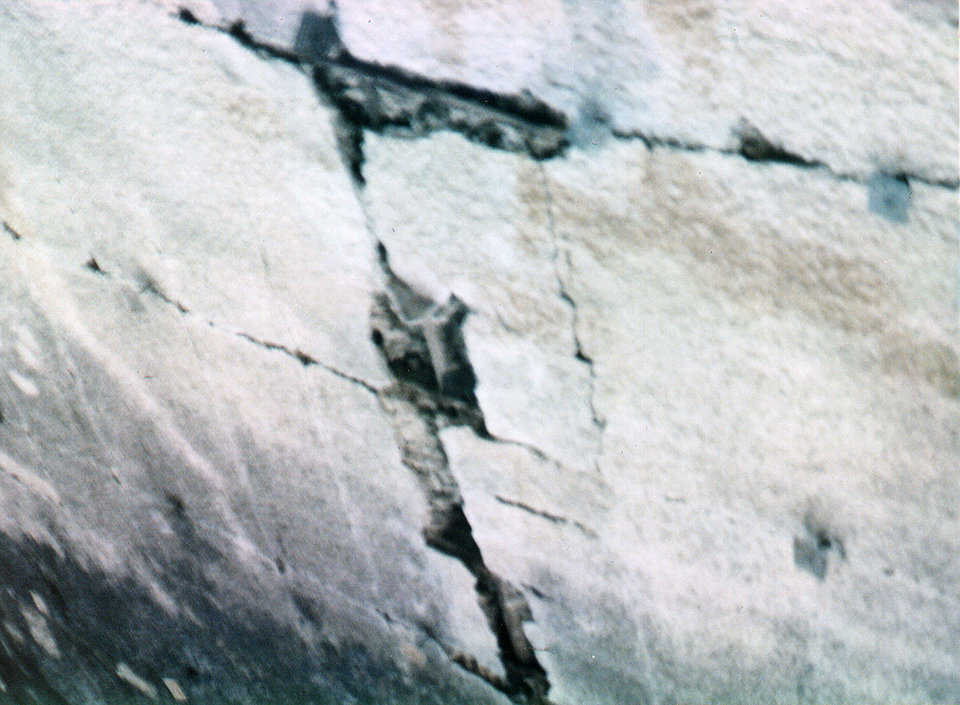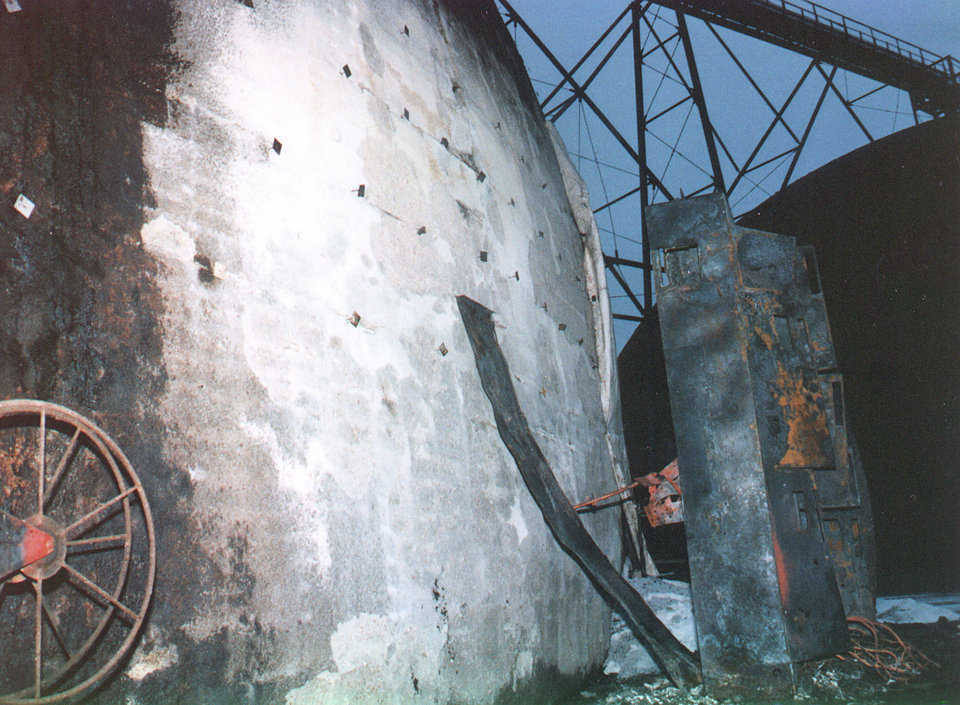
Fire damage from three wood structures and 300 gallons of transformer oil – Cargill – Channelview, TX
A violent, wind-driven fire fueled by three wood structures and 300 gallons of transformer oil burned about a third of the covering off this fertilizer storage. The fire was the worst possible. Late at night, wind blew the fire directly toward the building. The fire department was not immediately called, so the oil burned completely. Damage was most severe to the exterior. In a 12-square-foot area, urethane was totally burned off, but the rest suffered more minor damage. The foam could be cleaned and a coating or metal cladding could be installed over it. No damage was detected on the inside of the Monolithic Dome.
Note that the foam held the fire back for a considerable time, and then the nonflammable concrete ended any possibility of the flames burning through to the stored product. Materials inside the dome were totally unaffected by the fire, and the dome’s concrete interior never even got warm.
Foam: Fire Hazard and Fire Barrier
Editor’s Note: For more information on urethane foam, please review Urethane Foam: Magic Material and the Best Kept Insulation Secret, authored by David B. South with appendices by David Vaughn.
Foam as a Fire Hazard
When sprayed on the interior of a building, with no covering such as shotcrete or drywall, polyurethane foam can create a dangerous fire hazard.
Monolithic Domes are as close to fireproof as you can make a building with today’s technology. Yet they have urethane as a major component. Currently, urethane foam is the world’s best insulation, but let me tell you the rest of the story.
First impressions
When I first started in the foam business, I thought urethane foam was as good as fire proofing, since it was rated non-combustible or non-burning. A piece of foam set on fire with a match or torch will self-extinguish when the match or torch is taken away. The flames go out. This is especially true if the sample’s surface was previously burned a bit. The earlier burning creates a char that burns less well as it protects itself.
A sales pitch I used in selling my first big foam jobs was telling owners that they could “cancel their fire insurance” on their potato storages. The foam would protect the metal buildings so fire could not hurt them.
A deceptive test
That was a common misconception and part of the sales patter spouted by urethane foam supply companies in 1970. They were using ASTM (American Society for Testing and Materials) tests that urethane foam could easily pass, such as ASTM 1692-T. Basically, this test was performed by clamping a piece of urethane foam in a stand and lighting a Bunsen Burner under an edge of the foam for a few seconds. As soon as the Bunsen Burner was removed, the lit sample would self-extinguish. So, urethane foam easily passed this test and was designated as “self-extinguishing or non-burning.”
In early 1970, I performed experiments setting blocks of urethane foam on fire and then taking the fire away. The samples would flame out immediately. This foam did not have any large amounts of fire retardants. But, it would not pass any of the fire tests used today.
An early project
I started spraying urethane foam in southwest Idaho in 1970. An early job was lining the inside of a van body off a two-ton truck. The van body was used as a boiler house for a concrete company. We sprayed two inches of foam on the inside of the van to keep the boiler equipment, located within, from freezing. Unfortunately, an area of the van’s wall behind some piping was missed.
One night the pipe froze. The plant operator began thawing the pipes with a propane torch. It set some of the foam on fire. He slapped it out with his hand and thought, “That was interesting.” But he had been in on our discussions and had heard that urethane was virtually fire proof, so he went ahead and put the torch back on the pipes.
Suddenly, the van’s whole inside caught fire and totally burned the interior insulation. The extremely hot flames melted many of the metal parts as they destroyed everything within the van body. Luckily, the plant manager got out immediately because the fire lasted less than five minutes.
A reassessment
We decided to reassess this so-called non-burning, self-extinguishing theory. Obviously, foam could burn like gasoline and only self-extinguished when it was all gone.
In truth, we had turned the inside of the van into a reflector oven. The fire had instantly become very hot and the hotter it got the hotter and faster it burned. We had discovered what the fire industry would also learn: so-called self-extinguishing foam would, in fact, burn very well.
Because of our experience and many others like it here and abroad, we now know that there is no such thing as a urethane foam that does not create a fire hazard under certain conditions. This is not because urethane burns so well, but because it insulates so well.
The fact is, most modern urethane foams do not burn very well. Most are UL rated or Class I foams with a flame spread of less than 25. Even foams with added fire retardants can still be a fire hazard. But that hazard can be eliminated by isolating the urethane foam with a covering, such as concrete sprayed over the foam in a Monolithic Dome, or sheet rock used over foam in conventional structures.
Urethane is by far the world’s best commercial insulation. But when it is left exposed as a lining of a building, the foam helps turn the structure’s interior into a reflector oven. If a fire does start within the building, there is no place for the heat to go. The heat will radiate from the fire to the foam, be reflected back to the fire to radiate again to the foam, and be reflected back to the fire again and again.
Like mirrors that face each other and reflect light, urethane can reflect heat so the temperature rise becomes phenomenal.
What I learned:
An Upjohn engineer told me that a normal house will burn at a maximum temperature of about 3500 degrees Fahrenheit. Fire temperatures within a urethane foam lined metal building will hit 10,000 F degrees within 30 seconds.
It does not matter if the urethane is the most fire-retardant or the least fire-retardant; if a fire gets going on the inside of a building lined with exposed urethane, the fire accelerates. This happens because the urethane will not absorb any significant amount of heat. Obviously this becomes more of a problem if both walls and ceiling are insulated with exposed foam, than if just the ceiling is so insulated. And it is even more of a problem in buildings with flammable materials.
After a number of fires, the Federal Trade Commission (FTC) sued major urethane suppliers. The FTC and the suppliers decided on a consent decree that had the suppliers pay for more testing and stop advertising urethane foam as non-burning or self-extinguishing.
Factory Mutual Insurance and Underwriters Laboratories also got into the act by devising more appropriate tests. Their tests determined that a thermal barrier was the only way to protect foam from fire in any circumstance. Originally, approved thermal barriers were 3/4" plaster or 1/2" sheetrock over the urethane foam. Since then, many other products have been tested and approved as fire barriers.
Three Examples of Urethane as a Fire Hazard
An insulated, sugar beet storage in Toppenish, Washington
This was a huge, rigid frame, metal building, 120’ wide, 400’ long, 45’ high at its center, used for storing raw sugar beets as they came from the field. At one end, the structure had a doorway entrance 60’ wide. During the facility’s first operating year, the owners discovered that heat generated by the beets was more than anticipated, and the beets needed more ventilation.
While the building was empty, workers began cutting more vents in the structure. At first they were very careful. They chipped the foam off the metal for an area considerably larger than the vent. They put wet burlap on the foam surrounding the area to be removed. Then, they removed the section with a cutting torch.
The foam would ignite and quickly self-extinguish so there didn’t seem to be a problem. Soon the workers left both water and wet burlap behind as they continued cutting vents, using a scaffold to reach designated areas on the sidewall at a height of 25 feet.
On the last vent at the building’s rear, enough fire was created to begin reflecting. The fire began reflecting against the ceiling and the girts and beams of the side walls. Suddenly, there was enough heat for the fire to self-propagate.
This building was lined on both walls and ceiling with 3" of exposed urethane, so the fire spread very rapidly. Workers scuttled down the scaffold and ran for the door at the other end of the building. They barely made it. By the time workers reached that distant door, the fire and smoke were ahead of them, over their heads, so visibility was virtually zero. In less than five minutes, the foam burned off, and the entire building collapsed. The fire went out before the fire department could react!
A metal Quonset potato storage, 300’ long, in Pleasant Valley, Idaho
Fire started in the front of the building by men using a cutting torch on 16 badly bent door hinges. As they worked on the last hinge, they created enough fire to start the reflection process that got the building burning. The fire roared down the length of the building, gaining momentum all the way. When it hit the far end, the fire literally blew out the wall. The temperature rise was comparable to a low grade explosion.
Metal building used for potato processing in Rexburg, Idaho
This building had been sprayed with the most highly fire retardant foam available, that had a flame spread of less than twenty-five like foams available today. Evidently, fire was started by thieves smoking while siphoning gas from a truck inside the structure. The truck caught fire, forcing the thieves to forsake their siphons and cans and run for their lives. Flames shot through the building in just a few minutes and their tremendous heat destroyed all the equipment within the building and burned all the combustibles. Although the foam went out quickly after the initial flashover, other items burned furiously for a considerable time.
Areas over the vehicles were totally destroyed, but, in much of the building, the foam was charred less than 1/4 inch, which is characteristic of foams rated Class I. But the basic structure was damaged beyond repair, and all of its contents were totally lost. Had the urethane been covered with plaster, the fire would have been very localized.
Foam as a Fire Barrier
Now here’s the good news:
Urethane foam is an excellent fire barrier when used on the exterior of a building. There are numerous examples of urethane foam roofs saving a building from fire. Burning brands, that can include anything from hot embers to large pieces of burning wood, can lay on a urethane roof for a considerable time before burning through. The urethane insulated roof will simply char. If there is no external heat source, the fire will go out. Urethane requires a lot of heat to keep burning. Where the heat can radiate to the atmosphere, the urethane makes a superior fire barrier.
A mattress factory in Twin Falls, Idaho
Back in the days before we worried about heat sinks, thermal barriers and the like, we insulated a common wall in a mattress factory in Twin Falls, Idaho. We sprayed one inch of urethane foam on the metal wall to protect the office from losing heat into the furniture storage area. One night, the mattress storage area caught fire. That fire burned for a very long time.
The Fire Marshall told me that the fire was against the building’s common wall for better than an hour before they could cool it. He was amazed that the heat did not come through that common wall.
It didn’t because the urethane insulation sprayed on the wall reflected the fire’s heat back into the storage area, rather than allowing the heat to come through. The Fire Marshall declared that he knew of no other material, besides concrete, that could hold back fire for the time they needed to extinguish that fire.
The best fire doors
Since then, I find the best fire doors are metal on both sides of a urethane foam core. The metal takes care of surface combustion, and the foam insulation prevents the temperature from rising to the point of combustion on the non-burning side of the door.
Urethane foam as a thermoset
Then too, urethane foam is a thermoset; that means it cannot be heated and changed back into its original liquid form. When urethane burns, it does not liquefy and run – as other plastics, including expanded polystyrene or Styrofoam – do. Urethane either burns very hot, as would an exposed foam building lining, or it doesn’t burn well at all. There is no danger of urethane foam smoldering.
The real fire danger from urethane comes from its insulation value, since foam increases the temperatures within the fire areas. But any fire barrier, such as sheet rock, will prevent the urethane from burning by soaking up the heat.
Urethane foam is not much of a fire hazard while being sprayed. In other words, nothing out-gases from it that is highly combustible. Sometimes, various solvents used to clean the gun can be combustible, but the urethane itself is virtually non-combustible.
Foam extinguished a fire
Once, we were spraying a liner inside the back of a truck in our shop. Admittedly, the shop was full of stuff, including a pile of plastic sheeting, previously used as masking. A welder working nearby somehow got the plastic pile burning. A co-worker saw the fire and sprayed it out with a foam gun, faster than he could have with a fire-extinguisher. He sprayed right over the flames, encapsulated them and almost instantly extinguished the fire.
Foam components, Isocyanate and a caution
Urethane foam components, by themselves, are not a fire hazard and can be shipped without fire hazard labels.
But burning Isocyanate (as a separate chemical) gives off very toxic fumes. Great care should be taken not to breathe these toxic fumes. The chemical by itself will not support combustion. However, if you are disposing of empty Isocyanate drums by removing their tops, do not cut out the top with a cutting torch in a confined area. In fact, it’s best if you don’t cut out the top with a cutting torch at all. Can-opener top removers for barrels work far better than torches.
If you are using torches, be sure you do not breathe smoke generated by the burning of the Isocyanate. It will make you sick. This smoke is a first cousin to Phosgene gas, that was used on troops in World War I in Europe.
A good caution to remember is never burn organics. Even wood smoke can kill you. It’s far better to dispose of chemicals as recommended by their manufacturers than to release chemicals into our environment.
Foam and Monolithic Domes
It is absolutely vital that fire be prevented within a Monolithic Dome during its construction. In that short period when a dome is totally lined with urethane, but before the concrete is in place, a fire would be devastating. So caution must be exercised.
Using urethane foam on a Monolithic Dome is ideal. Notice, I said on the dome. Remember, we spray foam on the underside of the Airform, but the foam winds up on the upper side of the concrete. The foam, therefore, is totally protected from interior fire by the concrete shell. And, on the outside of the dome, the foam will not burn anyway and provides a substantial fire barrier.
Updated: August 2011

Fire Damage – Polyurethane only charred – Cargill – Channelville, TX
An outline of the wood building against the Monolithic Dome can be seen. This outline was left when the char from the two-by-fours was cleaned.

Fire damage is cosmetic and easily repaired – Cargill – Channelville, TX
With the foam burned off, the concrete is exposed. In a few places, sacrificial steel can be seen. This is a light network of rebar immediately tied against the urethane and covered with a small amount of concrete. Sacrificial steel is used as an anchor to tie the heavier steel reinforcing of the structure. So, the pitting pictured is of no consequence other than cosmetic.

Fire damage – Burned Transformer – Interior surface of dome never got warm – Cargill – Channelview, TX
Foam burned totally off the concrete exposed rebar hangers and bases, as well as the carcass of the old transformer. The 300 gallons of transformer oil, that were totally consumed, were in this area. But this building lost none of its functionality as a fertilizer bulk storage. Repairing damages only necessitated sandblasting or scrapping the charred foam and applying new foam.

Fire started by careless crooks.
This fire was started by some young men who were attempting to steal gasoline from the truck. One of the men dropped a cigarette. The fire blossomed and flashed over the entire structure in less than 5 minutes. They left their equipment in their hurry to get out.
The exposed foam intensified the heat to thousands of degrees F in just a few seconds. Note: the urethane on the door kept the fire from destroying the door.

Fire goes from bad to worse.
The truck tires fed the fire with heat and smoke. The insulation increased temperature which increased the speed at which the tires burned. The increased heat drooped the steel and melted the aluminum into puddles.

Warehouse was built in two sections.
One section was concrete block with a wood framed roof. The other section was a rigid frame metal building. The entire building was insulated with 1 inch of urethane foam on the interior surface.

Initial flashover of this fire set the wooden roof on fire.
Fuel provided by the roof was enough to burn off the urethane foam. Foam used on this structure was UL rated under 25 flame spread. It needed the extra fuel of the roof to burn off the foam. Note how the fire mangled all of the equipment within the sorting and bagging area.

Fire cooks the potatoes!
Concrete and twisted steel is all that survived — along with the baked potatoes.

Note the metal part of the building.
It is ruined — especially the roof structure. But it never fell in as might have been expected.

Fire melts the paint!
Where the air infiltrated around the dock, the fire damage was hottest and melted off the paint.

A sad survivor!
Much of the exterior of the building looks just fine. The building is destroyed but still standing.

Charred foam!
The UL rated foam (less than 25 flame spread) charred as the fire flashed over the interior of the building. In areas away from the wood there was not enough fuel to keep the fire going and it simply went out.

It is a fact;
All urethane should have a fire barrier over its face. It is not because it burns so well, but because it intensifies the fire by reflecting the heat back into the fire— thus accelerating it. The fire gets hotter and burns faster. Without extra fuel it will stop after the flashover.

What the flashover can do.
The flashover leaves behind a char that protects the foam from further burning unless there is a massive amount of heat near it. Urethane either burns very hot or not at all. It will flash when it is exposed and lines a building. But on the exterior of a building where the heat can get away, fire is not much of a threat.

Exposed urethane on interior walls is a serious mistake.
On the other hand, in the right place, it is amazing how much fire it can deflect — such as within the core of fire doors.